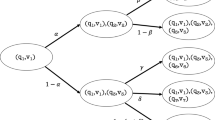Abstract
This paper deals with the problem of derivational redundancy in scientific explanation, i.e. the problem that there can be extremely many different explanatory derivations for a natural phenomenon while students and experts mostly come up with one and the same derivation for a phenomenon (modulo the order of applying laws). Given this agreement among humans, we need to have a story of how to select from the space of possible derivations of a phenomenon the derivation that humans come up with. In this paper we argue that the problem of derivational redundancy can be solved by a new notion of “shortest derivation”, by which we mean the derivation that can be constructed by the fewest (and therefore largest) partial derivations of previously derived phenomena that function as “exemplars”. We show how the exemplar-based framework known as “Data-Oriented Parsing” or “DOP” can be employed to select the shortest derivation in scientific explanation. DOP’s shortest derivation of a phenomenon maximizes what is called the “derivational similarity” between a phenomenon and a corpus of exemplars. A preliminary investigation with exemplars from classical and fluid mechanics shows that the shortest derivation closely corresponds to the derivations that humans construct. Our approach also proposes a concrete solution to Kuhn’s problem of how we know on which exemplar a phenomenon can be modeled. We argue that humans model a phenomenon on the exemplar that is derivationally most similar to the phenomenon, i.e. the exemplar from which the largest subtree(s) can be used to derive the phenomenon.








Similar content being viewed by others
References
Alonso, M., & Finn, E. (1996). Physics. Addison-Wesley.
Baader, F., & Nipkow, T. (1998). Term rewriting and all that. Cambridge University Press.
Bod, R. (1998). Beyond grammar: An experience-based theory of language. CSLI Publications/Cambridge University Press.
Bod, R. (2000). Parsing with the shortest derivation. Proceedings COLING 2000, Saarbruecken, Germany, pp. 69–75.
Bod, R. (2006). Towards a general model of applying science. International Studies in the Philosophy of Science, 20(1), 5–25.
Bod, R., Scha, R., & Sima’an, K. (eds.) (2003). Data-oriented parsing. University of Chicago Press.
Carbonell, J. (1986). Derivational analogy: A theory of reconstructive problem solving and expertise acquisition. In R. Michalski et al. (eds.), Machine learning (Vol. II, pp. 371–392). Morgan Kaufmann.
Cartwright, N. (1983). How the laws of physics lie. Oxford University Press.
Cartwright, N. (1999). The dappled world. Cambridge University Press.
Douglas, J., & Matthews, R. (1996). Fluid mechanics (Vol. 1, 3rd ed.). Longman.
Falkenhainer, B., Forbus, K., & Gentner, D. (1989). The structure-mapping engine: Algorithm and examples. Artificial Intelligence, 41, 1–63.
Friedman, M. (1974). Explanation and scientific understanding. Journal of Philosophy, 71, 5–19.
Giere, R. (1988). Explaining science: A cognitive approach. University of Chicago Press.
Giere, R. (1999). Science without laws. The University of Chicago Press.
Goodman, J. (2003). Efficient algorithms for the DOP model. In R. Bod, R. Scha, & K. Sima’an (eds.), Data-oriented parsing (pp. 125–146). CSLI Publications.
Hartmann, S. (1999). Models and stories in hadron physics. In M. Morgan & M. Morrison (eds.), Models as mediators (pp. 326–346). Cambridge University Press.
Hempel, C., & Oppenheim, P. (1948). Studies in the logic of explanation. Philosophy of Science, 15, 135–175.
Kitcher, P. (1981). Explanatory unification. Philosophy of Science, 48, 507–531.
Kitcher, P. (1989). Explanatory unification and the causal structure of the world. In P. Kitcher & W. Salmon (eds.), Scientific explanation (pp. 410–505). University of Minnesota Press.
Kolodner, J. (1993), Case-based reasoning. Morgan Kaufmann.
Kuhn, T. (1970). The structure of scientific revolutions, (2nd ed.), University of Chicago Press.
Manning, C., & Schütze, H. (1999). Foundations of statistical natural language processing. The MIT Press.
Morrison, M. (1999). Models as autonomous agents. In M. Morgan & M. Morrison (eds.), Models as mediators (pp. 38–65). Cambridge University Press.
Nickles, T. (2003). Normal science: From logic to case-based and model-based reasoning. In T. Nickles (ed.), Thomas kuhn (pp. 142–177). Cambridge University Press.
Norman, E., Riley, J., & Whittaker, M. (1990). Advanced design and technology. Harlow, UK:Longman
Salmon, W. (1990). Four decades of scientific explanation. University of Minneapolis Press.
Scha, R. (1990). Language theory and language technology: Competence and performance. In Q. A. M. de Kort & G. L. J. Leerdam (eds.), Computertoepassingen in de Neerlandistiek, Almere.
Scha, R., Bod, R., & Sima’an, K. (1999). A memory-based model of syntactic analysis: Data-oriented parsing. Journal of Experimental and Theoretical Artificial Intelligence, 11(3), 409–440.
VanLehn, K. (1998). Analogy events: How examples are used during problem solving. Cognitive Science, 22(3), 347–388.
Veloso, M., & Carbonell, J. (1993). Derivational analogy in PRODIGY: Automating case acquisition, storage, and utilization. Machine Learning, 10(3), 249–278.
Acknowledgments
The author is grateful to Margaret Morrison for insightful comments and suggestions on a previous version of this paper. All remaining shortcomings are entirely the author’s responsibility. This paper also benefitted from suggestions by an anonymous reviewer.
Author information
Authors and Affiliations
Corresponding author
Rights and permissions
About this article
Cite this article
Bod, R. Getting Rid of Derivational Redundancy or How to Solve Kuhn’s Problem. Minds & Machines 17, 47–66 (2007). https://doi.org/10.1007/s11023-007-9064-4
Received:
Accepted:
Published:
Issue Date:
DOI: https://doi.org/10.1007/s11023-007-9064-4




